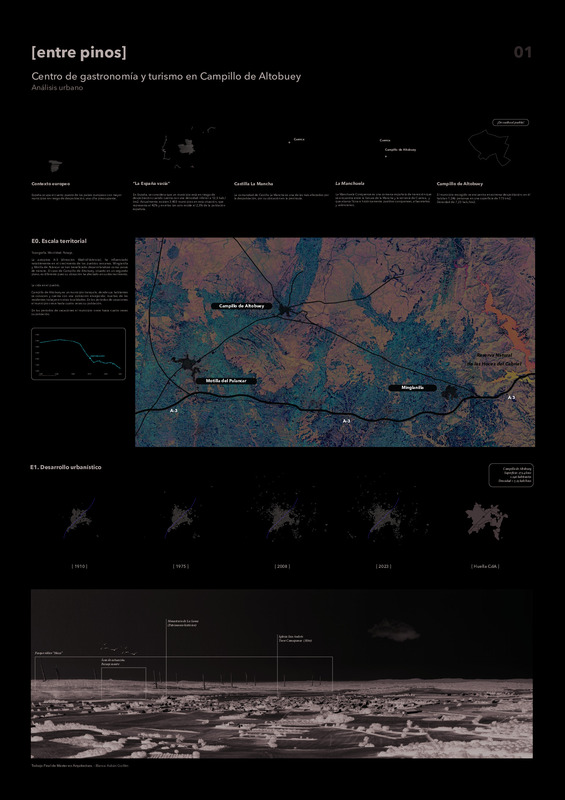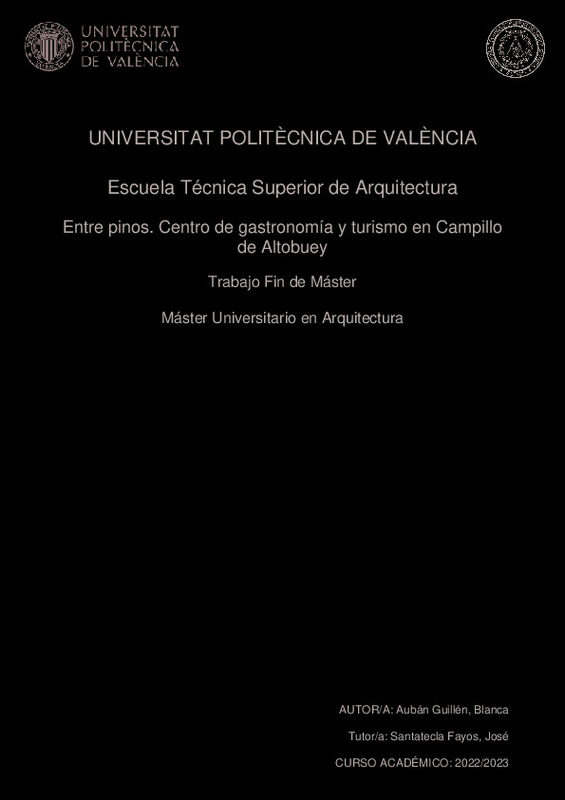|
Resumen:
|
[ES] El éxodo rural del campo a la ciudad de la década de los 60 en España supuso la despoblación de los municipios del interior de la península. Una de las comunidades más afectadas fue Castilla La Mancha, cuya población ...[+]
[ES] El éxodo rural del campo a la ciudad de la década de los 60 en España supuso la despoblación de los municipios del interior de la península. Una de las comunidades más afectadas fue Castilla La Mancha, cuya población continúa decreciendo; esta situación plantea dos problemáticas: por un lado, un reto demográfico, y por el otro el abandono del patrimonio rural.
Este proyecto pretende revitalizar el municipio de Campillo de Altobuey en la provincia de Cuenca que se encuentra en riesgo de despoblación. El edificio se sitúa en un área de pinos cercana al municipio, junto a unos bancales de piedra seca preexistentes -considerados patrimonio de la humanidad -.
El objetivo de este proyecto es fomentar el turismo rural en la zona y conseguir que los visitantes desconecten de la presión urbana de las ciudades y se relajen y sumerjan en la tranquilidad de este paraje natural. Para ello, el edificio se ha diseñado atendiendo a las trazas de los bancales de piedra seca y elevándose sobre el terreno dibujando un cuerpo ligero en el aire.
El programa se define como un centro de gastronomía y turismo que ofrece un recorrido lineal con distintas actividades y talleres para el aprendizaje culinario de los visitantes, un espacio de exposición de productos locales. Continúa en una terraza-mirador con una vista panorámica a Campillo de Altobuey y al Monasterio de la Loma; se completa la experiencia en el restaurante con la degustación de los platos típicos de la zona. Por último, el conjunto también dispone de pequeños alojamientos de uso turístico dispersos en el bosque
de pinos respetando la privacidad individual; se definen como cabañas con forma de cubos que disponen de las necesidades básicas para una pareja.
[-]
[EN] The rural exodus from the countryside to the city of the 1960s in Spain meant the depopulation of the municipalities of the interior of the peninsula. One of the most affected communities was Castilla La Mancha, whose ...[+]
[EN] The rural exodus from the countryside to the city of the 1960s in Spain meant the depopulation of the municipalities of the interior of the peninsula. One of the most affected communities was Castilla La Mancha, whose population continues to decline; this situation poses two problems: the first one, a demographic challenge, and the other one, the abandonment of the rural heritage.This project aims to revitalize the municipality of Campillo de Altobuey in the province of Cuenca which is at risk of depopulation. The building is located in an area of pine trees near the village, next to some preexisting dry stone terraces -considered a world heritage -.
The aim of this project is to promote rural tourism in the area and get visitors to disconnect from the urban pressure of cities and relax and immerse in the tranquility of this natural place. For this, the building has been designed taking into account the traces of the dry stone terraces and rising on the ground drawing a light body in the air.
The program is defined as a gastronomy and tourism center that offers a linear route with different activities and workshops for the culinary learning of visitors, an exhibition space for local products. Continue on a terrace-viewpoint with a panoramic view of Campillo de Altobuey and the Monastery of La Loma; the visitor can complete the experience in the restaurant with the tasting of the typical dishes of the area. Finally, the complex also has small tourist accommodation scattered in the pine forest respecting individual privacy; they are defined as cabins in the form of cubes that have the basic needs for a couple.
[-]
|








